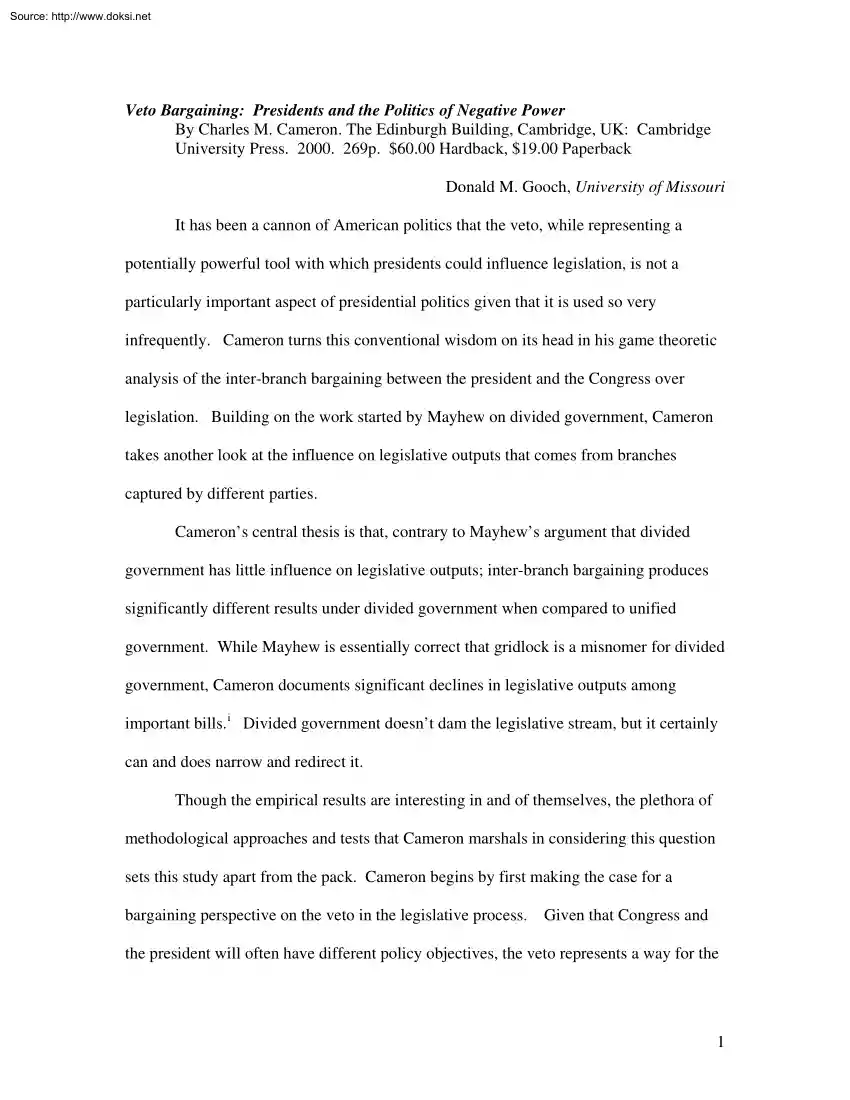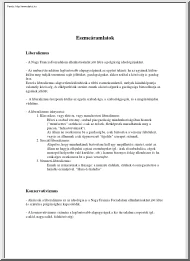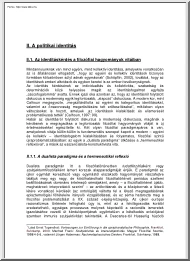Datasheet
Year, pagecount:2000, 4 page(s)
Language:English
Downloads:3
Uploaded:July 06, 2020
Size:466 KB
Institution:
-
Comments:
Cambridge University Press
Attachment:-
Download in PDF:Please log in!
Comments
No comments yet. You can be the first!Most popular documents in this category
Content extract
Source: http://www.doksinet Veto Bargaining: Presidents and the Politics of Negative Power By Charles M. Cameron The Edinburgh Building, Cambridge, UK: Cambridge University Press. 2000 269p $6000 Hardback, $1900 Paperback Donald M. Gooch, University of Missouri It has been a cannon of American politics that the veto, while representing a potentially powerful tool with which presidents could influence legislation, is not a particularly important aspect of presidential politics given that it is used so very infrequently. Cameron turns this conventional wisdom on its head in his game theoretic analysis of the inter-branch bargaining between the president and the Congress over legislation. Building on the work started by Mayhew on divided government, Cameron takes another look at the influence on legislative outputs that comes from branches captured by different parties. Cameron’s central thesis is that, contrary to Mayhew’s argument that divided government has little influence on
legislative outputs; inter-branch bargaining produces significantly different results under divided government when compared to unified government. While Mayhew is essentially correct that gridlock is a misnomer for divided government, Cameron documents significant declines in legislative outputs among important bills. i Divided government doesn’t dam the legislative stream, but it certainly can and does narrow and redirect it. Though the empirical results are interesting in and of themselves, the plethora of methodological approaches and tests that Cameron marshals in considering this question sets this study apart from the pack. Cameron begins by first making the case for a bargaining perspective on the veto in the legislative process. Given that Congress and the president will often have different policy objectives, the veto represents a way for the 1 Source: http://www.doksinet president to influence legislation, not just by killing a bill (singleton), but also as a step in
an iterative process towards a compromise between the two branches. This sequential veto bargaining constitutes the specific focus of Cameron’s treatment of the issue. Though it had been thought that vetoes were rare events (and compared to basic legislative productivity, they are), the probability of vetoes goes up with the legislative significance of the bill, and thus the probability of sequential veto bargaining. Thus the initial impression of a rarely utilized and marginal tool gives way to a more nuanced perception of an important strategic factor in legislative politics. Cameron builds his game theoretic model of veto bargaining through several steps that highlight the importance of incorporating the sophisticated assumptions and formulaic construction of each iteration. The sequential veto bargaining model (SVB) represents the definitive conceptualization of the bargaining process between the president and Congress. Incorporating incomplete information, uncertainty, and
repeated play, Cameron’s model explains how presidents use their reputation (credible threats of vetoes) and actual vetoes to extract concessions on legislation from Congress. Hence a key aspect of presidential power as identified by Neustadt, heretofore unassailable except in ad hoc and atheoretic descriptions, is specified precisely. The process involves successive bids by Congress to pass a bill closest to its ideal point that the president will accept. Since Congress is unsure as to where the president’s ideal point lies, he can use vetoes (or veto threats) to force the Congress to move the legislation in his direction (assuming that the concessions are preferred to the status quo). The play of the model depends very much on the location of the perceived range that the president’s ideal point lies within relative to the override player’s reservation policy 2 Source: http://www.doksinet range and Congress’s ideal point. The structure of the game allows learning from
round to round (hence the importance of the president’s policy reputation) and, depending on the president’s type, Congress makes bids for presidential acquiescence or for a bypass through override. If the president’s ideal point lies closer to Congress than the override player, the model predicts congressional concessions. However, if the override member’s ideal point is closer to Congress than the president, the model predicts that Congress will not make concessions and instead will pass a bill with the intent of overriding the expected veto by the president (no concessions). This sophisticated model solves the problem of the more basic models where no vetoes are predicted or where vetoes are merely the product of bad luck rather than strategic behavior. Cameron tests the models using original data and in novel situations not initially contemplated by the models. He demonstrates how the probability of vetoes decline as the ‘deadline’ of an election approaches, a result
implicit to the model and thus a confirmation of its veracity. Collecting and categorizing data on veto threats; Cameron finds that, as with vetoes, veto threats are more frequent during divided government and increase with legislative significance. Cameron concludes the study by bringing a contextual view to bear on vetoes, looking at selected veto bargaining from Eisenhower to George Bush, Sr. Gary King argued, in his famous article on the methodology employed in studying the Presidency, the nature of the institution (n = 1, etc.) need not be a bar to rigorous empirical research. ii Green and Shapiro suggested that rational choice literature has a dearth of empirical testing. They argued that ‘in our view, the case has yet to be made that these [formal] models have advanced our understanding of how politics works 3 Source: http://www.doksinet in the real world.” iii Cameron puts this contention very much in doubt with this work on veto bargaining. It is what Morton, in a
recent work, has pointed to as a way of ‘bridging’ the gap between the empiricism of the Behavioral Revolution and the precise theoretical models of formal theory: empirical formal theoretics. iv Cameron’s Veto Bargaining: Presidents and the Politics of Negative Power is a defining work in the merger of game theoretic modeling with empirical research as well as, representing one of the more innovative and rigorous examinations of presidential politics to date. It represents a challenge to those such as Green and Shapiro who suggest formal theory has little practical importance while placing the exclamation point on King’s argument that the presidency can and should be the subject of rigorous examination. In many respects, Cameron’s work is the culmination of the hopes for rational choice theory and presidential research and a resounding answer to the critics of formal theory. i Mayhew, David. 1991 Divided We Govern: Party Control, Lawmaking, and Investigations, 1946-1990
New Haven: Yale University Press. ii King, Gary. 1993 “The Methodology of Presidential Research” Pp 387-412 In Researching the Presidency: Vital Questions, New Approaches, edited by George C. Edwards III, John H Kessel, and Bert A. Rockman Pittsburgh: University of Pittsburgh Press iii Green, Donald P. and Ian Shapiro 1994 Pathologies of Rational Choice Theory: A Critique of Applications in Political Science. New Haven: Yale University Press iv Morton, Rebecca. 1999 Methods and Models: A Guide to the Empirical Analysis of Formal Models in Political Science. Cambridge: Cambridge University Press 4
legislative outputs; inter-branch bargaining produces significantly different results under divided government when compared to unified government. While Mayhew is essentially correct that gridlock is a misnomer for divided government, Cameron documents significant declines in legislative outputs among important bills. i Divided government doesn’t dam the legislative stream, but it certainly can and does narrow and redirect it. Though the empirical results are interesting in and of themselves, the plethora of methodological approaches and tests that Cameron marshals in considering this question sets this study apart from the pack. Cameron begins by first making the case for a bargaining perspective on the veto in the legislative process. Given that Congress and the president will often have different policy objectives, the veto represents a way for the 1 Source: http://www.doksinet president to influence legislation, not just by killing a bill (singleton), but also as a step in
an iterative process towards a compromise between the two branches. This sequential veto bargaining constitutes the specific focus of Cameron’s treatment of the issue. Though it had been thought that vetoes were rare events (and compared to basic legislative productivity, they are), the probability of vetoes goes up with the legislative significance of the bill, and thus the probability of sequential veto bargaining. Thus the initial impression of a rarely utilized and marginal tool gives way to a more nuanced perception of an important strategic factor in legislative politics. Cameron builds his game theoretic model of veto bargaining through several steps that highlight the importance of incorporating the sophisticated assumptions and formulaic construction of each iteration. The sequential veto bargaining model (SVB) represents the definitive conceptualization of the bargaining process between the president and Congress. Incorporating incomplete information, uncertainty, and
repeated play, Cameron’s model explains how presidents use their reputation (credible threats of vetoes) and actual vetoes to extract concessions on legislation from Congress. Hence a key aspect of presidential power as identified by Neustadt, heretofore unassailable except in ad hoc and atheoretic descriptions, is specified precisely. The process involves successive bids by Congress to pass a bill closest to its ideal point that the president will accept. Since Congress is unsure as to where the president’s ideal point lies, he can use vetoes (or veto threats) to force the Congress to move the legislation in his direction (assuming that the concessions are preferred to the status quo). The play of the model depends very much on the location of the perceived range that the president’s ideal point lies within relative to the override player’s reservation policy 2 Source: http://www.doksinet range and Congress’s ideal point. The structure of the game allows learning from
round to round (hence the importance of the president’s policy reputation) and, depending on the president’s type, Congress makes bids for presidential acquiescence or for a bypass through override. If the president’s ideal point lies closer to Congress than the override player, the model predicts congressional concessions. However, if the override member’s ideal point is closer to Congress than the president, the model predicts that Congress will not make concessions and instead will pass a bill with the intent of overriding the expected veto by the president (no concessions). This sophisticated model solves the problem of the more basic models where no vetoes are predicted or where vetoes are merely the product of bad luck rather than strategic behavior. Cameron tests the models using original data and in novel situations not initially contemplated by the models. He demonstrates how the probability of vetoes decline as the ‘deadline’ of an election approaches, a result
implicit to the model and thus a confirmation of its veracity. Collecting and categorizing data on veto threats; Cameron finds that, as with vetoes, veto threats are more frequent during divided government and increase with legislative significance. Cameron concludes the study by bringing a contextual view to bear on vetoes, looking at selected veto bargaining from Eisenhower to George Bush, Sr. Gary King argued, in his famous article on the methodology employed in studying the Presidency, the nature of the institution (n = 1, etc.) need not be a bar to rigorous empirical research. ii Green and Shapiro suggested that rational choice literature has a dearth of empirical testing. They argued that ‘in our view, the case has yet to be made that these [formal] models have advanced our understanding of how politics works 3 Source: http://www.doksinet in the real world.” iii Cameron puts this contention very much in doubt with this work on veto bargaining. It is what Morton, in a
recent work, has pointed to as a way of ‘bridging’ the gap between the empiricism of the Behavioral Revolution and the precise theoretical models of formal theory: empirical formal theoretics. iv Cameron’s Veto Bargaining: Presidents and the Politics of Negative Power is a defining work in the merger of game theoretic modeling with empirical research as well as, representing one of the more innovative and rigorous examinations of presidential politics to date. It represents a challenge to those such as Green and Shapiro who suggest formal theory has little practical importance while placing the exclamation point on King’s argument that the presidency can and should be the subject of rigorous examination. In many respects, Cameron’s work is the culmination of the hopes for rational choice theory and presidential research and a resounding answer to the critics of formal theory. i Mayhew, David. 1991 Divided We Govern: Party Control, Lawmaking, and Investigations, 1946-1990
New Haven: Yale University Press. ii King, Gary. 1993 “The Methodology of Presidential Research” Pp 387-412 In Researching the Presidency: Vital Questions, New Approaches, edited by George C. Edwards III, John H Kessel, and Bert A. Rockman Pittsburgh: University of Pittsburgh Press iii Green, Donald P. and Ian Shapiro 1994 Pathologies of Rational Choice Theory: A Critique of Applications in Political Science. New Haven: Yale University Press iv Morton, Rebecca. 1999 Methods and Models: A Guide to the Empirical Analysis of Formal Models in Political Science. Cambridge: Cambridge University Press 4





